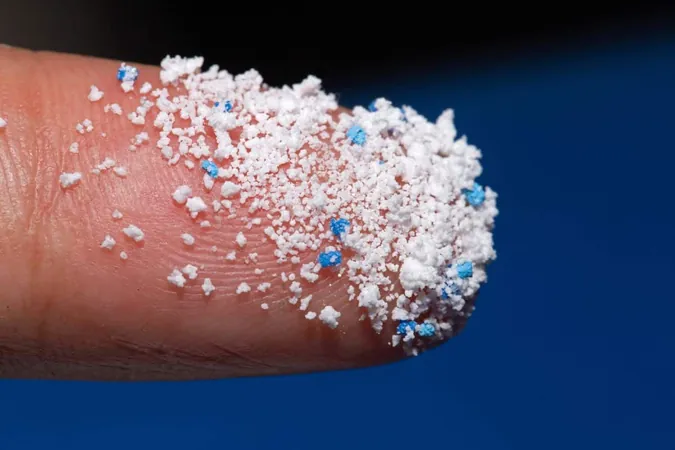
Are You Breathing in Cancer? The Shocking Truth About Microplastics
2025-01-13
Author: Ken Lee
Are You Breathing in Cancer? The Shocking Truth About Microplastics
In recent years, the alarming rise of microplastics in our environment has sparked urgent concerns for human health. These minuscule plastic particles, which are now found in the air we breathe, the water we drink, and the food we consume, are beginning to reveal a worrying connection to a plethora of health issues, including cancer, infertility, and respiratory diseases. As the evidence mounts, experts urge immediate global action to combat plastic pollution and promote safer alternatives.
What Are Microplastics and Where Do They Come From?
Microplastics are tiny plastic fragments measuring less than 5 millimeters, often resulting from the breakdown of larger plastic materials or from industrial processes. Annually, nearly 460 million metric tons of plastic are produced worldwide, and this figure is expected to multiply by almost three times by 2060. Their widespread dispersal into the environment occurs through various means, such as degradation of plastic waste, shedding from synthetic fibers, and particles emitted during vehicle wear and tear. Unfortunately, they have infiltrated even the most pristine environments, remote islands, and the Arctic.
The Health Impacts: Respiratory, Digestive, and Reproductive Concerns
A recent review of approximately 3,000 studies, published in the journal Environmental Science & Technology, underscores the dire health implications of inhaling microplastics. Key findings highlight alarming associations, including:
Respiratory issues: Inhaling microplastics may impair lung function and increase the likelihood of developing respiratory diseases, including lung cancer.
Digestive health: Studies suggest that ingestion of microplastics through contaminated food and water may increase the risk of gastrointestinal issues, including colon cancer.
Reproductive health: Both male and female fertility issues have been linked to long-term exposure to microplastics.
Though significant research has focused on animal models, the biological similarities to humans raise concerns about similar risks in people. Moreover, microplastics have a tendency to bioaccumulate, meaning prolonged exposure could exacerbate their detrimental effects.
Why Microplastics Are Hard to Avoid
Microplastics have found their way into virtually every aspect of our lives. From food sources like seafood to drinking water, and even single-use products, the challenge of avoiding these micro-pollutants is daunting. They may even be absorbed through the skin, although this is a less frequent method of exposure. Upon entering the body, microplastics can linger and may release hazardous chemicals that were incorporated during their manufacture.
Socioeconomic factors compound the issue, as individuals in lower-income regions often encounter greater plastic waste and pollution. These disparities can lead to a heightened risk of adverse health effects in vulnerable communities.
A Call for Action: What Can Be Done?
Despite the grim outlook, experts advocate for proactive steps to minimize the damaging repercussions of microplastics. Actions can include:
1. Personal Choices: Switching to natural fibers for clothing and opting for fresh, unpackaged foods can reduce exposure to microplastics in daily life.
2. Regulatory Changes: Governments should implement stricter regulations regarding plastic production. Policies such as banning nonessential single-use plastics and promoting accessibility to sustainable materials can reduce environmental contributions from microplastics.
3. Increased Awareness: Raising public consciousness about the dangers of microplastics and advocating for alternatives are vital for stimulating systemic change.
Dr. Nicholas Chartres, the lead author of the recent review, strongly suggests that governments could draw lessons from the regulation of tobacco products to curtail the proliferation of microplastics.
The Road Ahead
As global plastic production continues to surge, ignoring the implications of microplastic exposure could culminate in widespread health crises over the coming decades. However, scientists emphasize that there is still hope: if we act swiftly, we can significantly reduce the prevalence of microplastics in our environment, thereby protecting public health.
Addressing the multifaceted challenges posed by microplastics necessitates collective action—an opportunity lies before us to embrace sustainable practices and advocate for necessary legislative reforms. Each proactive step taken today is a step towards diminishing the insidious threat of these invisible invaders in the future.


 Brasil (PT)
Brasil (PT)
 Canada (EN)
Canada (EN)
 Chile (ES)
Chile (ES)
 Česko (CS)
Česko (CS)
 대한민국 (KO)
대한민국 (KO)
 España (ES)
España (ES)
 France (FR)
France (FR)
 Hong Kong (EN)
Hong Kong (EN)
 Italia (IT)
Italia (IT)
 日本 (JA)
日本 (JA)
 Magyarország (HU)
Magyarország (HU)
 Norge (NO)
Norge (NO)
 Polska (PL)
Polska (PL)
 Schweiz (DE)
Schweiz (DE)
 Singapore (EN)
Singapore (EN)
 Sverige (SV)
Sverige (SV)
 Suomi (FI)
Suomi (FI)
 Türkiye (TR)
Türkiye (TR)
 الإمارات العربية المتحدة (AR)
الإمارات العربية المتحدة (AR)